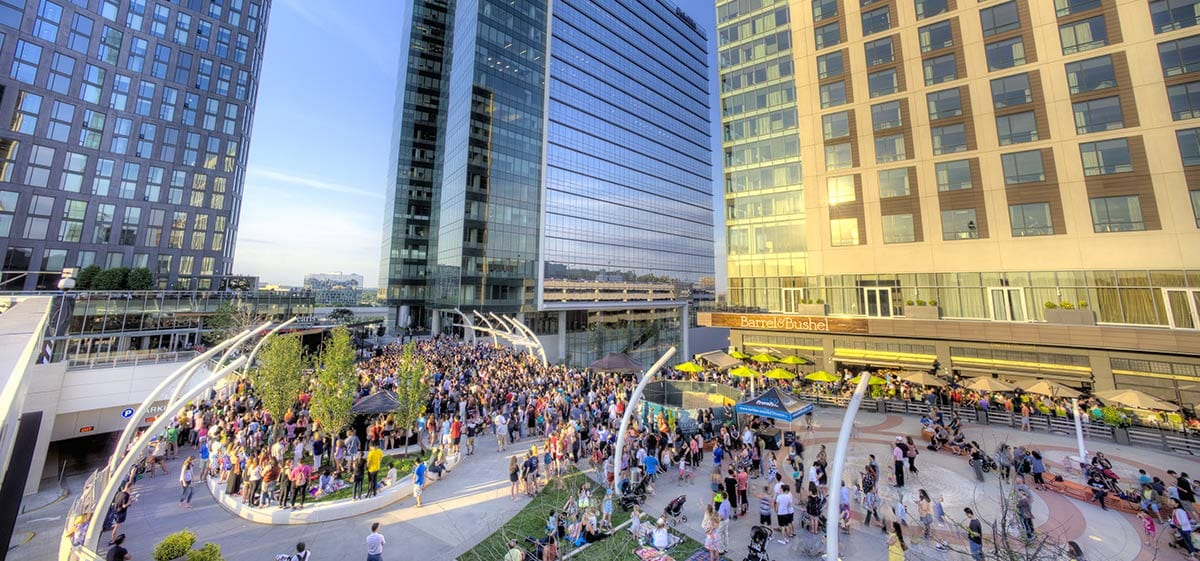Around the country, car-oriented suburban properties are trying to retool into redeveloped urban environments where residents, office workers, and shoppers can meet their needs near transit, without relying solely on automobiles.
A poster child for this kind of redevelopment is Tysons, Virginia. Known as an “edge city” – growing from old-school suburban to mixed-use urban – Tysons features one of the nation’s largest and most well-known shopping malls: Tysons Corner Center.
Originally built in 1968 adjacent to the new I-495 National Capital Beltway that circles the Washington, DC region, this suburban mall complex was purchased in 2005 by the Macerich Company. Macerich has since been executing its plans for a high-density, mixed-use center adjacent to the new Silver Line Metrorail station that serves the DC metro region.
More People Without More Vehicles
One challenge: how to fit more people into the area without cramming even more vehicles. Macerich’s answer: TDM, or “transportation demand management” – a fancy term that simply means finding more transportation options without constantly expanding road systems. This TDM work earned Macerich the ACT (Association for Commuter Transportation) 2017 Award for Outstanding Building and Development.
“TDM (transportation demand management) = Increasing transportation options without expanding traditional traffic infrastructure”
TDM Solution: Access Tysons
No matter how innovative, such a high-density project requires serious attention when it comes to managing – and reducing – vehicular traffic. In other words, Macerich needed to develop a world-class transportation demand management (TDM) program to help shoppers, resident, and workers find their way around the development without the need for more vehicles or costly parking.
Macerich’s Tysons Corner Center has managed its transportation demand management program, Access Tysons, for the past 10 years throughout the development’s continued growth and expansion. This expansion includes, in addition to the mall:
- Tysons Tower, a 22-story building with over 500,000 RSF, owned and operated by Hines development
- VITA, the property’s onsite residential building with 429 luxurious studios, and one-, two-, and three-bedroom apartments
- The Hyatt Regency Hotel, with 300 hotel rooms, 33,000 square feet of meeting and event space, and a 7,000-square-foot regency ballroom
Macerich worked extensively with planners, builders, property management companies, and on-site transportation professionals to ensure transportation facilities and improvements were a key aspect of Tysons Corner Center as it expanded. Each building was pre-planned to include direct Metrorail and bus access, bike parking, carshare availability, information displays and more.
Access Tysons’ Transportation Amenities
Under the Access Tysons TDM plan, Tysons Corner Center’s transportation amenities include:
- Two carshare vehicles
- Two real-time displays of numerous transportation options, the first projected onto a six-foot-wide window over a door that connects the mall to the Tysons Corner Metro Station and the second at VITA apartments
- Over 10 recently upgraded bike parking facilities throughout the property
- One Capital Bikeshare station connecting Tysons with Washington DC metropolitan area’s largest bikeshare network
- A business center with free Wi-Fi, coffee machine, real time display of transportation options, and direct access to the pedestrian bridge leading to Metro
Finally, Access Tysons hosts a website, www.accesstysons.com, where visitors can find details about all transportation options available to them.
Access Tysons: The Bottom-Line Results
How has the Access Tysons TDM program performed? Well, there is a reason Macerich claimed an award for their efforts. Results have shown that the development’s efforts are improving transportation access and mobility to, from, and on the property. For example:
- In 2016, Tysons Tower saw trip reduction percentages of 72%. When comparing survey data from 2015 to 2016, Tysons Tower has seen a drive alone rate decrease of 3%.
- In 2016 VITA saw a trip reduction percentage of 71%. Through a survey data comparison of 2015 and 2016, VITA saw a decrease in drive alone rates from 51% to 40%. Walk-to-work rates also increased from 11% to 24%. This can be credited to Macerich’s work on maintaining their outdoor plaza, their involvement in hosting community oriented events, such as the Turkish Heritage festival, free on site work out classes, on campus fairs, markets, and more.
- Access Tysons also experienced success through their individual efforts with companies on-site, promoting benefit programs like the DC-area Metro’s SmartBenefits. Both Macerich and Hyatt entered the program, thereby increasing accessibility of Metro to employees, especially for Hyatt, whose survey data showed that 36% of their employees take transit. In their first year in the program, Hyatt signed six employees up to the SmartBenefits program.

